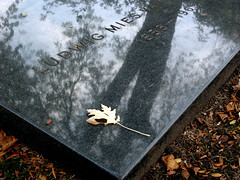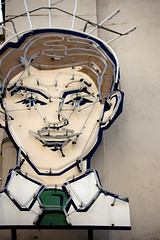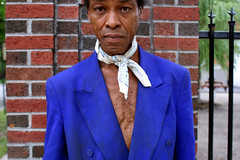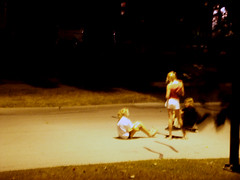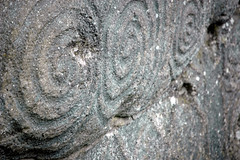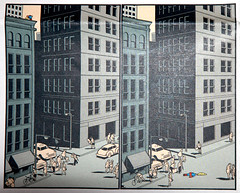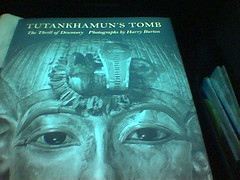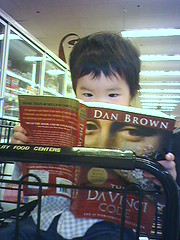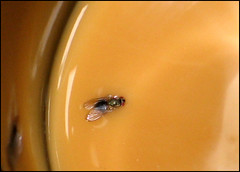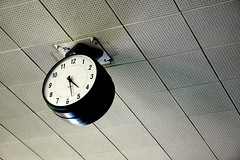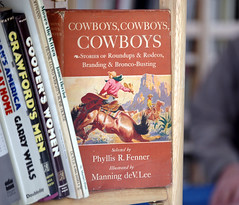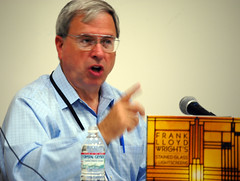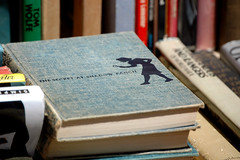And my personal favorite: nutjob means
Friday, June 30, 2006
what the people want to know
The month is up -- here's an selected list of the things that people searched out detritus for during the month of June from Google, Yahoo, MSN and Technorati -- not necessarily the most popular hits, but certainly the most entertaining:
hr puffinstuff boogaloos
funktionslust
sucking chest wound photos (I suspect they were disappointed)
buy lacrimus rioja
is guinness good for you
arnold horseshack sound clip (sorry: no audio. just daffodils.)
"Picador in a Bullfight," Picasso
FLW taliesin cheney murder scene photos (oh my. more gore. more disappointment.)
animaris ondula
smartcar
sitcom sets
the bridge poem like currents through my head
karaoke gentle on my mind
And my personal favorite: nutjob means
And my personal favorite: nutjob means
roll your own tombstone
When my grandfather died our family delayed getting his grave marker for over a year. (That’s just the way we do things in my family.) The pack of us – my grandmother, an aunt, an uncle, assorted kids and spouses -- drove out to his graveside on the first anniversary of his death and decided it was time to do something about the cement block that marked his grave.
We gathered in the Funeral Director’s office and started flipping through the sample book and telling stories. As is also per usual in my family, the stories were rich with dark humor, and pretty soon we were all laughing.
In the office of the funeral director of the funeral home.
This was one of those tears running down the face, big gulps of air kind of laughing.
The only one in the room who wasn’t laughing was the Funeral Director.
My grandmother, always one for propriety, dabbed a tear from her eye and said to the director: “You’ll have to forgive us.”
To this day I don’t know if he was deadpanning his reply or if he spent too much time among the dead, but the answer he came back with -- with a cold stone expression was: “It helps to laugh.”
That brought the room down in a hurry.
But to my point. As we were flipping through the sample book of possible headstone designs my first thought was: “Bad clip art.” The book was overflowing with every sentimental piece of clip art that ever came pre-loaded in Microsoft Word. Roses; Irish Setters; Men fishing from small watercraft.
And were expected to pick one of these for my Bompa, who in his spare time had architected his dream home in lines that echoed Frank Lloyd Wright and Mies van der Rohe and outfitted the whole with modernist furnishings and fixtures (and whose only bad design judgment, in the years that I knew him, involved flocked wallpaper -- but it would be dishonoring the dead to tell that story).
It occurred to me that where there was a scrap of clipart there was an EPS file; and I was handy enough to know how to create one of those. The room was quiet at this point – the director having killed our laughter – so I asked him if he could accept an EPS file, and from there everything fell into place. He called the monument company; they said sure; I delivered it; they engraved it in the stone.
I based the design off a rectilinear Frank Lloyd Wright stained glass piece, and dropped in a Chi Rho symbol that I took as a wax rubbing off a headstone from Lakeview Cemetery where it marked the grave of an archbishop. (I never took pictures of the finished stone, regrettably, but I’ll snap a few the next time I visit.)
I was reminded of all this earlier today when Béla Fleck and the Flecktones shuffled by on my iPod. It was a wonderful live recording of Amazing Grace, and it reminded me of the day we laid Bompa down.
The graveyard was a 45 minute drive from the church where the service was held, so by the time we arrived the memorial service was already somewhat distant and the few words that the pastor said over the grave didn’t seem sufficient.
We threw in our dirt and then milled around, my aunt making tremendously talented small talk with the few guests who had joined us for the long drive.
The whole thing felt unfinished.
My brothers and sister and I gathered on the far edge of the plot -- we could see Mt Rainier in the distance (my grandfather loved that mountain) -- and we bitched a bit about how something more was needed. My dad joined our little group, agreed with our bitching, and started to sing Amazing Grace.
We joined him, and held each other. My grandmother heard us and joined our circle, and then my aunt, and then my uncle.
My grandmother was the only one who knew all the verses (of course) and she led us through them. We followed a half beat behind, stumbling through a few tears, the strength of the circle holding us up. Slowly, haltingly, we sang Bompa home.
(To this day I lose it when I hear that song. I'm usually all right until the very last verse -- and then as soon as we hit "Bright shining as the sun" I'm a slobbery mess.)
Thursday, June 29, 2006
this man wants me
 One of the first things I did when I moved to Chicagoland was subscribe to Steppenwolf Theatre -- 'cause yeah, you already know about my thing for curmudgeons, and member Malkovich is right near the top of that list.
One of the first things I did when I moved to Chicagoland was subscribe to Steppenwolf Theatre -- 'cause yeah, you already know about my thing for curmudgeons, and member Malkovich is right near the top of that list.Plus Steppenwolf has always had a reputation for being some of the best theatre that Chicago has going.
But here's the problem: Some years later, it hasn't been. I can recall maybe three memorable productions. Okay: Four.
And only one chance to see my boy M on stage. (Curiously, I’ve only seen Malkovich twice on stage – once in London and once in Chicago -- and both times he played the heir apparent of an Eastern Bloc country. What are the odds?)
So this year I didn't re-enlist, deciding instead to drop the coin on the one or two shows that I might really want to see at Steppenwolf, and then spread the rest of the wealth to some of the other great productions that are running in this city – that would include chasing the skirts of Mary Zimmerman wherever she may flit.
Then I got this email from David Hawkanson, Executive Director of Steppenwolf:
Renew your subscription by July 31st and if the 2006-2007 season does not completely meet your expectations, we'll provide a full refund.
hmmmmmmmmmm.
All of it?
In essence, we're so confident you'll be satisfied by our upcoming season that we're willing “to put our money where our mouth is.” All of the productions will offer great acting of compelling stories, each in our intimate theatres. If after seeing all five plays you are disappointed in the Steppenwolf experience, we'll refund your money at the end of the season.
But how come?
We do not want to lose you as a subscriber. For whatever reason you've been reluctant to renew, please take this offer seriously.
So it seems I was not alone in assessing the suckitude of recent Steppenwolf seasons -- they've organized a whole marketing campaign around recovery.
Give me a few. I'll think it over.
sr xing
old age sticks up Keep
Off
signs)&
youth yanks them
down(old
age
cries No
Tres)&(pas)
youth laughs
(sing
old age
scolds Forbid
den Stop
Must
n't Don't
&)youth goes
right on
gr
owing old
e.e. cummings
one more for the list
The words are carefully written in pencil on top of a page torn from spiral notebooks: “Loving Your Enemies.” They are scribbled hastily on a torn, creased sheet, cutting across its ruled lines: “We come to the seat of government.” They are squeezed into the yellowed margins of annotated books: “Religion must work here.” They are written on a frayed slip of paper, folded as if long-carried in a wallet: “Gandhi speaks for us.”…
And they are sometimes reused, evolving from a quickly penned phrase on the back of a typescript -- “Today the whirlwinds of revolt are shaking our nation” – into something more resonant: “The whirlwinds of revolt will continue to shake the foundations of our nation until the bright day of justice emerges.”
From the notes and writings of Martin Luther King (as reported in this morning’s NYT), recently on the auction block at Sotheby’s, and just acquired by Morehouse College (thank god) for an undisclosed sum.
The exhibition will be cut short as a result of the acquisition – it comes down at 1pm today. (Run.)
Wednesday, June 28, 2006
i love my country, goddammit.
The Fourth is coming. I’ve made my list.
Yellowstone.
Yosemite.
Barack Obama & Maxine Waters (my ticket for 2008).
Jazz. The Blues. Rock and Roll.
Silicon Valley (dang you guys are smart – and you’re keeping me employed – keep it coming.)
Ansel Adams.
New York City.
Chicago.
Seattle.
The Rocky Mountains.
Route 66.
Thoreau.
Ragtime. Bluegrass. Motown.
Abraham Lincoln.
The Underground Railroad (because they stuck it to the f*ckers).
Gordon Parks.
Cary Grant.
Jimmy Stewart.
Sarah Vowell, my favorite partly cloudy patriot.
David Sedaris.
Stonewall.
Jacob Lawrence.
Thomas Jefferson.
We the People.
John Muir (convert).
Elaine Stritch.
Broadway.
Hollywood.
Studs Terkel.
Denise Levertov.
My Grama.
The Beats.
The Nuyoricans.
Gertrude Stein.
John Steinbeck.
Canyonlands. Zion. Goblin Valley.
Frank Lloyd Wright.
Chief Joseph (with my deep regrets).
Jane Addams.
Jacob Riis (another convert).
Sojourner Truth.
Any train traveling between two major US cities and crossing a mountain range.
DC Comics.
Google.
Schoolhouse Rock.
There’s more, of course, but these are the first that come to mind. And I’ll save the “could use improvement” list for later.
Happy Birthday, America. You’re awfully good at f*cking things up, but I’m awfully glad you’re mine.
(Besides: a girl gotta dance with him what brung her. But that part where the rest of the world is pissed at us? Let's do something about that next.)
Yellowstone.
Yosemite.
Barack Obama & Maxine Waters (my ticket for 2008).
Jazz. The Blues. Rock and Roll.
Silicon Valley (dang you guys are smart – and you’re keeping me employed – keep it coming.)
Ansel Adams.
New York City.
Chicago.
Seattle.
The Rocky Mountains.
Route 66.
Thoreau.
Ragtime. Bluegrass. Motown.
Abraham Lincoln.
The Underground Railroad (because they stuck it to the f*ckers).
Gordon Parks.
Cary Grant.
Jimmy Stewart.
Sarah Vowell, my favorite partly cloudy patriot.
David Sedaris.
Stonewall.
Jacob Lawrence.
Thomas Jefferson.
We the People.
John Muir (convert).
Elaine Stritch.
Broadway.
Hollywood.
Studs Terkel.
Denise Levertov.
My Grama.
The Beats.
The Nuyoricans.
Gertrude Stein.
John Steinbeck.
Canyonlands. Zion. Goblin Valley.
Frank Lloyd Wright.
Chief Joseph (with my deep regrets).
Jane Addams.
Jacob Riis (another convert).
Sojourner Truth.
Any train traveling between two major US cities and crossing a mountain range.
DC Comics.
Google.
Schoolhouse Rock.
There’s more, of course, but these are the first that come to mind. And I’ll save the “could use improvement” list for later.
Happy Birthday, America. You’re awfully good at f*cking things up, but I’m awfully glad you’re mine.
(Besides: a girl gotta dance with him what brung her. But that part where the rest of the world is pissed at us? Let's do something about that next.)
big brother on a budget
It does raise the possibility that you could get people to behave more co-operatively or pro-socially by putting up pictures of eyes.
Behaviorial biologist Dr. Melissa Bateson of Newcastle University commenting on a study that suggests “the feeling of being watched makes people act more honestly, even if the eyes are not real”.
Reported today by the BBC »
Tuesday, June 27, 2006
looking for mr. demille

Last home movie for awhile -- promise.
I love the way the light dances around in this clip -- I sliced out a handful of frames and spliced them together into a grid that reads (chronologically) like Mayan hieroglyphs -- two across and then down the column before circling back up to the right.
This Super8 was shot the same year that I was easily amazed by alphabets. Still 5 and clearly the queen of ham.
There’s no sound but if you look close you can almost see the words: “Are you making a movie?” take shape -- and then I move in for my close up.
All this messing around with old movies has made we wonder about the ways we mark time and tell our stories -- to ourselves and to anyone else who will listen.
Our stories are our artifacts -- the objects that give time shape and weight.
Without them -- without stories, without memories -- we face the danger that time may move too quickly and leave us behind too soon.
coming back around
Things I've taken up again after jettisoning them when I was a kid due to some measure of ridicule:
smooshing my ice cream with the back of my spoon until it's just the right consistency
staring into the far distance when I'm just sitting there thinkin'
telling jokes that nobody gets but me (because every once in a while somebody laughs)
brubeck on shuffle
Sure, yeah: everybody loves Take Five -- but have you heard the track off «Buried Treasures», recorded live by the Dave Brubeck Quartet in Mexico City in 1967?
It's a whole different place. (And it's where I want to be.)
(Actually, that whole CD is where I want to be.)
Here it is at iTunes »
It's a whole different place. (And it's where I want to be.)
(Actually, that whole CD is where I want to be.)
Here it is at iTunes »
Monday, June 26, 2006
love me a locaburg
I’m regularly astonished by the photography of locaburg, a photographer on Flickr who ranges around, between and beyond Mexico City and Detroit.
It’s his portraits that do it to me. Raw and real, they generally share one thing in common: His subjects give, without giving it all away.
They allow the camera’s gaze, and they give it back with interest.
The only time I’ve ever caught a taste of something like the dust that falls in the wake of this guy’s footsteps as he passes by with his Canon was the time I asked a woman dying indigo in El Salvador if I could take her photo. She generously said yes, and the shot she gave me was startling -- but yeah, right, I know -- not even close to a Locaburg.
There’s such strong regard in locaburg’s photographs for his subjects. They don’t give away everything, but that they give what they do give -- and that locaburg handles it with the respect he does -- that, in itself, is everything.
Here’s Locaburg’s photostream »
[update] Locaburg's pics will be published next year as The Detroit Book by the Contemporary Art Museum in Detroit »
It’s his portraits that do it to me. Raw and real, they generally share one thing in common: His subjects give, without giving it all away.
They allow the camera’s gaze, and they give it back with interest.
The only time I’ve ever caught a taste of something like the dust that falls in the wake of this guy’s footsteps as he passes by with his Canon was the time I asked a woman dying indigo in El Salvador if I could take her photo. She generously said yes, and the shot she gave me was startling -- but yeah, right, I know -- not even close to a Locaburg.
There’s such strong regard in locaburg’s photographs for his subjects. They don’t give away everything, but that they give what they do give -- and that locaburg handles it with the respect he does -- that, in itself, is everything.
Here’s Locaburg’s photostream »
[update] Locaburg's pics will be published next year as The Detroit Book by the Contemporary Art Museum in Detroit »
Sunday, June 25, 2006
hippie kids, pt 1
It was inevitable: I've discovered YouTube. I won't blame enyasi entirely, but if you get tired of my new video addiction, you can blame her on my behalf.
In this Super8 clip I'm five. My younger brother is the first one on the screen; my older sister is spazing out around the edges of the frame.
We're on a beach somewhere in the Bay Area in the early 70s -- we lived in Sonoma at the time.
Shortly after this clip was taken my mother disappeared from my life for awhile -- for about 7 years, actually. We never really got back on track after that.
I don't have a lot of memories of her when I was younger, so this film clip startled me when she shared it with me. That's her behind the camera. Just looking at her daughter, and loving her.
Imagine that.
less without and more within
I’m in the camp that thinks Shakespeare was probably the best storyteller who ever put words to paper. But I’m not in the camp that thinks it’s important to know what he looks like. (We’ll leave discussions about whether or not he may have been Marlowe and a spy for the Queen out of it for the time-being.)
Regarding his appearance: It seems I may be on my own.
So how will things change for me if I know whether he was “grave, austere and puritanical” or a “plumpish, unassuming man with brown eyes, sensuous lips, near shoulder-length hair and a forehead heightened by a receding hairline”?
If I know whether or not “he wears his collar rakishly untied” will there are more things in heaven and earth, Horatio, than are dreamt of in your philosophy cause me to wonder a little bit less?
I saw a clumsy open-air regional production of The Tempest Friday night, which broke several important rules of doing Shakespeare right – chief among them being: Ingenues must be hot (’cause I’ve gotta want to see you guys work this thing out).
In the final act, as the temperature dropped and the players, earnest though they were, showed little evidence of being able to overcome a bad mike job (its chief virtue being a keen demonstration of the Doppler effect), I gave up on trying to extract anything meaningful from the staging and laid down, the grass at my back, stars tracing the perimeter of the tree’s canopy overhead, and the language was all I needed to see Miranda and Ferdinand married and dispatched – to do whatever it was that needed to be done on their wedding night.
And, lying on my back, without visuals to interfere and just that beautiful, beautiful language in my ears, they were hotties indeed.
The stuff that dreams are made of.
Regarding his appearance: It seems I may be on my own.
Since Shakespeare’s time (1564-1616) eight portraits have seemed to be genuine likenesses, but today only three of them stand up, and even those are not indisputable. They are the focus of a fascinating show, “Searching for Shakespeare,” that opens today at the Yale Center for British Art, its only appearance in the United States.
From «How Shall We Know Thee? By Severe, Bohemian or Courtly Mien» in Friday’s New York Times.
So how will things change for me if I know whether he was “grave, austere and puritanical” or a “plumpish, unassuming man with brown eyes, sensuous lips, near shoulder-length hair and a forehead heightened by a receding hairline”?
If I know whether or not “he wears his collar rakishly untied” will there are more things in heaven and earth, Horatio, than are dreamt of in your philosophy cause me to wonder a little bit less?
I saw a clumsy open-air regional production of The Tempest Friday night, which broke several important rules of doing Shakespeare right – chief among them being: Ingenues must be hot (’cause I’ve gotta want to see you guys work this thing out).
In the final act, as the temperature dropped and the players, earnest though they were, showed little evidence of being able to overcome a bad mike job (its chief virtue being a keen demonstration of the Doppler effect), I gave up on trying to extract anything meaningful from the staging and laid down, the grass at my back, stars tracing the perimeter of the tree’s canopy overhead, and the language was all I needed to see Miranda and Ferdinand married and dispatched – to do whatever it was that needed to be done on their wedding night.
And, lying on my back, without visuals to interfere and just that beautiful, beautiful language in my ears, they were hotties indeed.
The stuff that dreams are made of.
To shame the guise o’the world, I will begin
The fashion: less without and more within
Cymbeline, v.i l.32-2
Saturday, June 24, 2006
the ideal candidate
Oh dear. What is it, precisely, about my “blogging behavior” that makes researchers at the University of Texas think that I am an “ideal candidate” to provide answers (where 1= “Strongy disgree” and 7= “Strongly agree”) to questions like:
And there's more where that came from.
Sorry guys: I’m all about research, but your dale carnegie-esque questions are kinda creeping me out. (Not to mention that Assistant Professors should have figured out spell check by now – see “strongy disgree”, “poinions” and “belive”.)
Any takers? You can find the link to the survey here »
- I seldom know what to say or do to get others to like me.
- If I put my mind to it, I could get anybody to like me.
- If I want someone to like me, I can usually create positive feelings between us.
- I am good at getting others to want to hang around with me.
- I tend to associate less with people who are critical.
- I often visit people without being invited.
- I am cautious about expressing my poinions until I know people quite well. (Editor’s note: I’m afraid I don’t know what a “poinion” is – does that disqualify me?)
- I am very sensitive to any sign that a person might not want to talk to me.
- It seldom embarrasses me to ask someone for a favor.
- I often say what I belive, even when it alienates the person with whom I am speaking.
And there's more where that came from.
Sorry guys: I’m all about research, but your dale carnegie-esque questions are kinda creeping me out. (Not to mention that Assistant Professors should have figured out spell check by now – see “strongy disgree”, “poinions” and “belive”.)
Any takers? You can find the link to the survey here »
like mustard without beef
I work at a shelter once a month. It's a no camera zone which are becoming increasingly rare in my life as I grab shots in the oddest of places (random sidewalks, the bathroom at Bloomingdales, Chicagoland tollways).
I work the sign-in table with my darlin' companion. Our job is to greet the guests and capture from their ID cards (the organization that runs the place hands them out) their name, birth date, gender and race on the sign-in sheet.
We also note whether they're there for dinner only or overnight; would they like a bag lunch in the morning; how about an early wake up call?
It's lights on at 6AM at the shelter, so an early wake up means 5.30, 5, 4.30AM.
A lot of them take the early call. A lot of them are working.
When I was working a job that was getting me down in a huge way, my monthly shift had a knack for hitting just when my tolerance had reached the limit. I was ready to walk -- just walk, because of all the bullshit around me -- and then I'd sit down and sign folks in -- old men, young men, women, women with their children. And by the end of the night I'd know with confidence that I didn't have it so bad.
Signing folks in gives me a chance to say hello and make eye contact with folks who spend a lot of their day invisible. I like that.
But there's also an emotion that attends that sign-in period that I've had a hard time defining. I try to stay friendly and warm during that hour, but not too perky, ‘cause these folks especially can smell phony a mile away. Lot of the faces have become familiar friends -- we'll chat some more during the evening ahead -- so the welcome is genuine, but it's always hard.
None of them would be there if they had another choice. There's always a little bit of embarrassment. It's my job to make that shame invisible – and to see them without it. As the hour passes by something strong wells up in my chest: card after card passes in front of me -- this guy has the same birthday as my younger brother; these kids will be heading out to their high school in the morning, where no one knows where they spent the night; this woman is probably a grandmother: does her daughter know she’s here?
It's not pity that I feel -- I made a pact with myself a while back to banish that emotion because it has none of the heft or empathy of compassion -- but the feeling that comes is still a feeling that's hard to handle.
I decided to blog about it a little when I rec'd a spam email this morning -- I opened the message (subject line: NEW’n’HOT Get the Recognition You Deserve!) to see if it had a #*@*! opt-out option, and I found this in the footer, along with some other inchoate ramblings:
I work the sign-in table with my darlin' companion. Our job is to greet the guests and capture from their ID cards (the organization that runs the place hands them out) their name, birth date, gender and race on the sign-in sheet.
We also note whether they're there for dinner only or overnight; would they like a bag lunch in the morning; how about an early wake up call?
It's lights on at 6AM at the shelter, so an early wake up means 5.30, 5, 4.30AM.
A lot of them take the early call. A lot of them are working.
When I was working a job that was getting me down in a huge way, my monthly shift had a knack for hitting just when my tolerance had reached the limit. I was ready to walk -- just walk, because of all the bullshit around me -- and then I'd sit down and sign folks in -- old men, young men, women, women with their children. And by the end of the night I'd know with confidence that I didn't have it so bad.
Signing folks in gives me a chance to say hello and make eye contact with folks who spend a lot of their day invisible. I like that.
But there's also an emotion that attends that sign-in period that I've had a hard time defining. I try to stay friendly and warm during that hour, but not too perky, ‘cause these folks especially can smell phony a mile away. Lot of the faces have become familiar friends -- we'll chat some more during the evening ahead -- so the welcome is genuine, but it's always hard.
None of them would be there if they had another choice. There's always a little bit of embarrassment. It's my job to make that shame invisible – and to see them without it. As the hour passes by something strong wells up in my chest: card after card passes in front of me -- this guy has the same birthday as my younger brother; these kids will be heading out to their high school in the morning, where no one knows where they spent the night; this woman is probably a grandmother: does her daughter know she’s here?
It's not pity that I feel -- I made a pact with myself a while back to banish that emotion because it has none of the heft or empathy of compassion -- but the feeling that comes is still a feeling that's hard to handle.
I decided to blog about it a little when I rec'd a spam email this morning -- I opened the message (subject line: NEW’n’HOT Get the Recognition You Deserve!) to see if it had a #*@*! opt-out option, and I found this in the footer, along with some other inchoate ramblings:
The sign-in shift is kinda like that: Stirs up a fire in the gullet, with nothing to cool it down.
Sympathy without relief is like mustard without beef.
Thursday, June 22, 2006
the sun and the rain and the apple seed
Sketchy though they were, the biographical facts were enough to make anyone question the saintly Golden Books version of Johnny Appleseed (the child bride?!), but it was a single botanical fact about the seeds themselves that made me realize that his story had been lost, probably on purpose.From «The Botany of Desire: A Plant’s-Eye View of the World» by Michael Pollan
The fact, simply, is this: apples don’t “come true” from seeds – that is, an apple tree grown from a seed will be a wildling bearing little resemblance to its parent. Anyone who wants edible apples plants grafted trees, for the fruit of seedling apples is almost always inedible – “sour enough,” Thoreau once wrote, “to set a squirrel’s teeth on edge and make a jay scream.”
Thoreau claimed to like the taste of such apples, but most of country men judged them good for little but hard cider – and hard cider was the fate of most apples grown in America up until Prohibition. Apples were something people drank. The reason people in Brilliant wanted John Chapman to stay and plant a nursery was the same reason he would soon be welcome in every other cabin in Ohio: Johnny Appleseed was bringing the gift of alcohol to the frontier.
(Am I the only one who thinks it's cool that this guy is writing about plants and his name is Pollan?)
this really happened
Many years ago around Halloween my ex- and I were driving away from our old place on Capitol Hill in Seattle -- we were headed out of the city somewhere, down 15th Ave -- and he said: "hey: those guys are smashing pumpkins".
Outraged that someone would be smashing some kid's jack o' lantern in broad daylight I said: "What?! That's terrible! We should stop them!" He said: "No -- Smashing Pumpkins -- that bald guy and his band -- they're standing outside Coastal Kitchen."
And so they were -- waiting for a seat to grab a bite to eat.
(true story. I swear.)
Outraged that someone would be smashing some kid's jack o' lantern in broad daylight I said: "What?! That's terrible! We should stop them!" He said: "No -- Smashing Pumpkins -- that bald guy and his band -- they're standing outside Coastal Kitchen."
And so they were -- waiting for a seat to grab a bite to eat.
(true story. I swear.)
craft your heart out
I was getting to know a new co-worker yesterday -- we cleared all the early hurdles and it became clear that we were sympathetic souls. The conversation continued in IM, and then she asked me "do you knit? (or am I pushing it?)"
Brilliant.
I regret that I don't. All the cool kids do.
But I my ply my own crafts and they mean the world to me. While I don't work in yarn and buttons, what enyasi said so beautifully this morning goes for me too:
Brilliant.
I regret that I don't. All the cool kids do.
But I my ply my own crafts and they mean the world to me. While I don't work in yarn and buttons, what enyasi said so beautifully this morning goes for me too:
We all come to craft for some reason. Maybe it is a desire for some thing we can’t afford a quest for some item that can’t be purchased or a need to work with our hands.
Or maybe, like me it is a need to frame our sorrows and loss with a handmade gilded creation, to lift the darkness with a coat of fresh paint, wrap our aching spirits in a knitted shawl, to adorn our souls with buttons and glitter and to not only wear our hearts for all to see, but to also trim them with ribbons.
—enyasi writing this morning in little brown girl 2.0
Wednesday, June 21, 2006
sins of the fatherland
What’s interesting from a grand perspective is that this is the first time you see formal territorial markers, people getting together and peeing on a chunk of land to claim it as their own.Florida State archaeologist William Parkinson commenting in Solar Circle: A 7,000-year-old henge in eastern Germany may be the world's first observatory in the July/August 2006 issue of «Archaeology» on a 7,000 year old henge that was recently excavated, reconstructed and opened to the public in Goseck, Germany.
Interesting piece if only because gives me one more pencil mark to make on my map of “cool sites I need to visit before I die”, but also because one of the sidebars is especially poignant. It reads:
After the end of WWII, German archaeologists avoided discussing the achievements of prehistoric Central Europeans because the Nazis had attempted to prove their belief in German superiority – and their war against the Jews – through the gross manipulation of archaeological evidence.Goes on to say that times, they are a changin’ – but it’s sobering to be reminded what a madman at the helm can do to throw a country off course even long after he’s gone.
For decades after the end of the war, the country’s scholars avoided fully interpreting prehistoric Central Europe culture, most especially anything that could be viewed as glorifying early Germanic people. “It was just find and label,” says University of Wisconsin-Milwaukee archaeologist Bettina Arnold. “Archaeologists would play it safe, and make catalogs, interminable catalogs, like listing and mapping all the Bronze Age shaft-hold ax heads in Central Europe.”
Tuesday, June 20, 2006
chi-lexicon redux
Many thanks to Gaper's Block who posted on the chi-lexicon piece and brought many new datapoints to our door. Thank you, too, to everyone who had something to say -- here's what we now know after a flurry of comments:
F***wad appears to be more prevalent in usage than f***stick (I think that we can safely say that f***stick is the insult in its potentiality and f***wad is the insult in its realization).
Variations not to be overlooked: dickwad, jagoff, jag.
Rubbernekkin and sigalert are synonymous with gaper's delay.
Sunshine delay is when the natural universe is responsible for the delay (I suppose we could also call it the "blinded-like-a-mole-rat delay" -- but in all honesty I've never heard that in actual use), and we call our expressways by their proper Christian names rather than their numbers, to better curse them by. (see example: "F.U. Dan Ryan!")
You can hang, bang or pull a U-eey, so long as it's a hard louie. Or if you're from the North suburbs you can flip a bitch. Same diff.
(And this started out as such a nice, clean blog.)
For the curious: there's more where that came from. Read the comments here »
F***wad appears to be more prevalent in usage than f***stick (I think that we can safely say that f***stick is the insult in its potentiality and f***wad is the insult in its realization).
Variations not to be overlooked: dickwad, jagoff, jag.
Rubbernekkin and sigalert are synonymous with gaper's delay.
Sunshine delay is when the natural universe is responsible for the delay (I suppose we could also call it the "blinded-like-a-mole-rat delay" -- but in all honesty I've never heard that in actual use), and we call our expressways by their proper Christian names rather than their numbers, to better curse them by. (see example: "F.U. Dan Ryan!")
You can hang, bang or pull a U-eey, so long as it's a hard louie. Or if you're from the North suburbs you can flip a bitch. Same diff.
(And this started out as such a nice, clean blog.)
For the curious: there's more where that came from. Read the comments here »
bauhausfrau
 I'm guilty of buying this bottle of wine only because the label reminded me of bauhaus print design -- and in spite of the fact that I could give a fig for (most) bordeaux.
I'm guilty of buying this bottle of wine only because the label reminded me of bauhaus print design -- and in spite of the fact that I could give a fig for (most) bordeaux.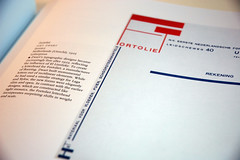
being ware
A «Quick Preparatory Quiz» from the poster-size brochure accompanying «The Public Exhibition of Original Cartoon Drawings, Preparatory Doodles and Printed Ephemera Selected From the Life Output Thus Far of the Juvenile Book Artist, Typographical Stylist, and Comic Strip Lobbyist Mr. F.C. Ware» now running at the Museum of Contemporary Art in Chicago
1. As a child, you were
a. sort of happy. b. not so happy.
2. To occupy your time, you like to
a. watch television. b. go to movies. c. draw. d. play video games. e. talk in weird voices into a tape recorder. f. read comic books.
3. The presence of members of the opposite and/or attractive sex makes you feel
a. weird. b. awful. c. terrified. d. hopeless. e. like killing yourself.
4. If you don’t like a comic strip, it’s because
a. it sucks. b. the cartoonist is an idiot.
5. If you don’t like a painting, it’s because
a. you don’t understand it. b. you’re ignorant of the history of art theory and art in general.
If any of these questions made any sense at all to you, you are now welcome to enter the exhibit. Please do not speak loudly, carry beverages, or scratch your initials into the plexiglass.
Chris Ware is the Flemish Master of comic art. Not only because he executes a scene the way they did -– by painting achingly small and vulnerable players against the big sweeping backdrop of the city in which they live –- but also because he gets that thimbleful of grief just right -– the thing that Auden wrote about --
About suffering they were never wrong,Ware builds a scene with exacting details and then occasionally telescopes it forward, back and sideways in time in Run Lola Run style. It’s wonderfully engaging, hard on the eyes, and takes hours to devour. Tough going for a museum show like the one that’s running at the MCA through (nearly) the end of August; better that you pick up one of his books and sit awhile.
The Old Masters: how well they understood
Its human position; how it takes place
While someone else is eating or opening a window or just walking dully along
Labels:
chris ware,
comics,
exhibits,
graphic novel,
museum,
museums,
quote
Sunday, June 18, 2006
chi-lexicon
Maybe people use these everywhere, but I had never heard them until I moved to Chicago:
Nutjob: a not entirely rational person, i.e. not a Midwesterner
F***stick: an inconsiderate person
Soup to Nuts: beginning to end (I asked someone where this came from and he said: “Like with a meal – you start with soup and you end with nuts.” And I said: “Do you end a meal with nuts? Do you know anyone who does?” And he said: “Well, no. But that’s what it means.”)
T-boned: what happens when some nutjob turns left on a yellow light and the other traffic is still moving through the intersection
Gaper’s Delay: what happens when someone gets T-boned; variation: Gaper’s Block
the squaring of the circle
On the night of Saint Andrew I found the Squaring of the Circle, at the end of the lamplight and of the night and of the paper I was writing on.
-- Leonardo da Vinci
From a placard in the Museum of Science and Industry’s Leonardo da Vinci exhibition (cause everyone’s gotta ride that DaVinci Code wave).
I thought this line (albeit in translation) had such a lovely poetry about it -– the insight found at the very end of the line, after a night’s (week’s? month’s?) labor -– out of lamp oil, out of paper, out of time –- and then the answer comes.
It has a little bit of tragedy to it too: If in fact Leonardo did find the answer that night to the squaring of the circle –- “using a finite compass and straightedge construction to make a square with the same area as a given circle” -- it was lost with the other 80% of his notebooks that were also lost (goddamit).
According to Wikipedia (O great fount of all knowledge that can be retrieved with just a click) it can't be done: “A solution of the problem of squaring the circle by compass and straightedge demands construction of the number [the square root of π], and the impossibility of this undertaking follows from the fact that π is a transcendental number — that is, it is non-algebraic and therefore a non-constructible number. If one solves the problem of the quadrature of the circle, this means one has also found an algebraic value of π, which is impossible.”
Oh well. A girl can dream (of poetry and brilliant men).
you can bury me in these

When I was a kid we had standard issue PJs – fuzzy sleepers with feet during the cold Colorado winters; much lighter fare designed to survive the summer heat in our little non-air conditioned house. (My big sister, in the top-bunk, hogged the one open window in our room, while I sweltered in the bottom bunk where the air didn’t move. Not that I'm bitter. Not at all.)
But my favorite PJs were my dad’s concert Ts.
I was allowed to dip into them only when the laundry had piled up and I had nothing else to wear. They were in the bottom drawer of the old oak bureau with the curved front panel and the dovetailing along the sides (found for a song before antiques were fashionable -- along with the vintage Maxfield Parrish prints that sons were tossing into the trash after their mothers had died. My dad always had an eye for talent – and a bargain.)
The drawer was fairly full with concert T-shirts of bands that my dad had promoted or knew somehow. Most of them were soft and worn; all of them smelled good. They’d gone through the wash by now so the sweet smell of tobacco had disappeared and all that was left was that safe, strong daddy smell.
I had two favorites: The Doors, because the letters looked so cool, and the Dead – a skeleton wearing a rose crown – because it scared me a little bit, but also because it was the softest and most well-worn of the bunch. My dad’s a big guy – around 6 foot 4 – and I was small enough that I could pull them on and they would fall to my knees. Watching the Boogaloos on a Saturday morning I could tuck my legs in and the whole T would snug around me like a little cocoon.
My dad held onto those Ts for years – he’d crack that they were “hole-y” and they were – riddled with holes, but more than that: they were holy vestments of memory. For him they meant the business, the music, the magic. For me they meant my daddy.
And it doesn't get any better than that.
Happy Father’s Day, Dad. I love you to pieces.
Saturday, June 17, 2006
beinahe nichts – almost nothing
I’ve been working up to this all week, and I still don’t know how to write about Plano and what I saw there.
Like Crown Hall, Mies’ Farnsworth House made a tremendous emotional impact. But this one didn’t leave me giddy.
The spare rectilinear form of Farnsworth has been likened to a Zen temple – but I think it’s more Shinto than Zen, more deeply connected to the landscape and the spirits that dwell within it -- and completely unafraid to want something more.
That same spark of desire that hit me at Crown Hall visited me at Farnsworth: But I wanted something different here. Crown Hall is about doing, making, and achieving. Farnsworth filled me with a desire to be still. A desire to be simple. A desire to move carefully and pay attention to each living thing that shared that moment with me.
It is beautifully and completely what it was designed to be: a place for one individual to get away on the weekend. I can’t imagine that it could be occupied more fully than that. It can be visited, of course, and there’s room to share a meal and drink on the patio with dear friends. To talk long into the night, to stoke the fire and share stories on that boundary-less travertine that stretches like a far horizon into the landscape that surrounds it.
But then the guests must go, and the single occupant will bed down in the far corner, which really isn’t far from anything, the house is so compact – to fall asleep under the trees and wake again, with the sunrise. (There could be no escaping the sunrise in a house where the walls are all glass.)
I’ve never slept so deeply and completely as I have on extended camping or sailing trips, in large part because my body soon acclimates to the rhythms of the sun, waking with the sunrise. Sleeping in a tent, of course, the sun finds you regardless of the tent walls. Sleeping on a boat I’ve always been miserable in the close confines of a cabin, so I usually manage to find my way up to the deck and the stars. And of course the sun finds you there too – but that’s as it should be. I imagine sleeping at Farnsworth would be something like that.
The stories about Farnsworth’s commission and Mies’ execution vary according to who serves them up. One of the rumors is that Farnsworth, a kidney specialist from Chicago and a single woman, took a liking to Mies and he took a liking to her – for the duration of the project. Then, as costs ran high – he used only the finest travertine, the most exceptional Primavera wood, and spent many, many hours of design and fabrication time on the doorknob for the front door (just one example) – they grew tired of one another, and then irascible. They wound up in court before all was said and done. Mies won and Farnsworth wound up paying more than double the original $40K that she had budgeted for the expense.
She called the house her Mies-conception (her journals about the experience are online at the Farnsworth house site) – but can you blame her? She wanted a weekend getaway – she wound up with a masterpiece.
A masterpiece without central air, only one working window and no mosquito screens – which anyone who’s spent any time in Illinois in the summertime will explain to you borders on inhumane.
She had to bully Mies into building her a storage cabinet to house her stereo equipment and, on the reverse, a few pieces of clothing. (Mies had offered her only a hook in the bathroom for her clothes – because who could want more, for a weekend, than what would fit on a single hook?)
She was surrounded by a structure that – while being almost nothing (Mies’ beinahe nichts), enforced a rigorous simplicity – and simplicity is something you have to want.
Ascetics want simplicity because they expect to be transformed by it. If transformation isn’t on your shopping list, simplicity is penal. Deprivation dominates.
It was impossible to capture the house in photography, but I tried anyway. Here’s a brief slideshow for the brave and the forgiving »
And here's the address to the house. (Just go.):
The Farnsworth House
14520 River Road
Plano, IL 60545
Tel (630) 552-0052
farnsworthhouse.com
Like Crown Hall, Mies’ Farnsworth House made a tremendous emotional impact. But this one didn’t leave me giddy.
The spare rectilinear form of Farnsworth has been likened to a Zen temple – but I think it’s more Shinto than Zen, more deeply connected to the landscape and the spirits that dwell within it -- and completely unafraid to want something more.
That same spark of desire that hit me at Crown Hall visited me at Farnsworth: But I wanted something different here. Crown Hall is about doing, making, and achieving. Farnsworth filled me with a desire to be still. A desire to be simple. A desire to move carefully and pay attention to each living thing that shared that moment with me.
It is beautifully and completely what it was designed to be: a place for one individual to get away on the weekend. I can’t imagine that it could be occupied more fully than that. It can be visited, of course, and there’s room to share a meal and drink on the patio with dear friends. To talk long into the night, to stoke the fire and share stories on that boundary-less travertine that stretches like a far horizon into the landscape that surrounds it.
But then the guests must go, and the single occupant will bed down in the far corner, which really isn’t far from anything, the house is so compact – to fall asleep under the trees and wake again, with the sunrise. (There could be no escaping the sunrise in a house where the walls are all glass.)
I’ve never slept so deeply and completely as I have on extended camping or sailing trips, in large part because my body soon acclimates to the rhythms of the sun, waking with the sunrise. Sleeping in a tent, of course, the sun finds you regardless of the tent walls. Sleeping on a boat I’ve always been miserable in the close confines of a cabin, so I usually manage to find my way up to the deck and the stars. And of course the sun finds you there too – but that’s as it should be. I imagine sleeping at Farnsworth would be something like that.
The stories about Farnsworth’s commission and Mies’ execution vary according to who serves them up. One of the rumors is that Farnsworth, a kidney specialist from Chicago and a single woman, took a liking to Mies and he took a liking to her – for the duration of the project. Then, as costs ran high – he used only the finest travertine, the most exceptional Primavera wood, and spent many, many hours of design and fabrication time on the doorknob for the front door (just one example) – they grew tired of one another, and then irascible. They wound up in court before all was said and done. Mies won and Farnsworth wound up paying more than double the original $40K that she had budgeted for the expense.
She called the house her Mies-conception (her journals about the experience are online at the Farnsworth house site) – but can you blame her? She wanted a weekend getaway – she wound up with a masterpiece.
A masterpiece without central air, only one working window and no mosquito screens – which anyone who’s spent any time in Illinois in the summertime will explain to you borders on inhumane.
She had to bully Mies into building her a storage cabinet to house her stereo equipment and, on the reverse, a few pieces of clothing. (Mies had offered her only a hook in the bathroom for her clothes – because who could want more, for a weekend, than what would fit on a single hook?)
She was surrounded by a structure that – while being almost nothing (Mies’ beinahe nichts), enforced a rigorous simplicity – and simplicity is something you have to want.
Ascetics want simplicity because they expect to be transformed by it. If transformation isn’t on your shopping list, simplicity is penal. Deprivation dominates.
The architecture of the Farnsworth House celebrates technology – at least the technology of the late 1940s, when it was designed – and yet it seems even more to honor the impulses of softness and peaceful coexistence. Modernity and technology, it tells us, are not inconsistent with modesty, serenity, and the most humane aspects of civilization. It is difficult to describe the sense of peace that you feel when inside the house, in part because it is somewhat unexpected.
We think of Mies’architecture as rigid. It is certainly not casual, but neither is it controlling. His clean, clear lines and planes are not there to make us straight and pure as they are. Yes, they enforce a certain discipline – no one in a Miesian space feels right giving in to the chaos – but you feel that the precision, far from confining, is what liberates you. Every person who enters becomes a natural foil for the rational structure, conscious of the fact that your body, like the great maple tree out front, is itself a piece of nature.
Paul Goldberger writing in Farnsworth: The Lightness of Being in the July | August 2004 issue of Preservation
It was impossible to capture the house in photography, but I tried anyway. Here’s a brief slideshow for the brave and the forgiving »
And here's the address to the house. (Just go.):
The Farnsworth House
14520 River Road
Plano, IL 60545
Tel (630) 552-0052
farnsworthhouse.com
Friday, June 16, 2006
happy bloomsday, folks.
Today’s the day, of course, that Stephen Daedalus and Leopold Bloom meander through Dublin to arrive finally at “yes I said yes I will yes”.
But that last scene is in part why Ulysses was hit with obscenity charges when it was first released, so we’ll keep it clean and instead dredge up the moment when Stephen’s remembering his mother on her deathbed from the tower at Sandycove (see pic up above – yep, that’s the one).
All I know is: If Joyce were writing today, Microsoft Word spell- and grammar-check might well drive him to distraction. (It objected to about half of the words and grammatical constructions in this passage -- and this is one of the straightforward ones.)
Wanna see more of what Joyce saw from his parapet at Sandycove? Here's a brief slideshow »
But that last scene is in part why Ulysses was hit with obscenity charges when it was first released, so we’ll keep it clean and instead dredge up the moment when Stephen’s remembering his mother on her deathbed from the tower at Sandycove (see pic up above – yep, that’s the one).
Woodshadows floated silently by through the morning peace from the stairhead seaward where he gazed. Inshore and farther out the mirror of water whitened, spurned by lightshod hurrying feet. White breast of the dim sea. The twining stresses, two by two. A hand plucking the harpstrings merging their twining chords. Wavewhite wedded words shimmering on the dim tide.
A cloud began to cover the sun slowly, shadowing the bay in deeper green. It lay behind him a bowl of bitter waters. Fergus’ chords. Her door was open: she wanted to hear my music. Silent with awe and pity I went to her bedside. She was crying in her wretched bed. For those words, Stephen: love’s bitter mystery.
Where now?
— James Joyce, Ulysses
All I know is: If Joyce were writing today, Microsoft Word spell- and grammar-check might well drive him to distraction. (It objected to about half of the words and grammatical constructions in this passage -- and this is one of the straightforward ones.)
Wanna see more of what Joyce saw from his parapet at Sandycove? Here's a brief slideshow »
Thursday, June 15, 2006
architecting a sitcom
Caught just a snatch of an interview with Louis C.K. on Fresh Air this afternoon and was intrigued with the way he talked about designing the set -- spare and with the intention of focusing the energy of the scene.
Fully intended to circle back and listen to the rest once I cleared the day's deadlines, but forgot (of course) until just now when the same guy showed up on the Daily Show and had me snorting with laughter (you know the kind I mean: the kind that catches you off guard and would be mortifying if it happened in public).
Funny guy. We cancelled HBO after Sex and the City went off the air: May just have to bring it back to catch Lucky Louie.
We wanted to make a set where there's no tzotchkes -- I just think there's so much put into the realism of sitcom sets that it takes away the funny ... so what I asked for was just a set where it's just blank walls like the Honeymooners -- just nothing -- I wanted it to be in a little box and have nowhere to go -- and have the energy just stay trapped -- we don't have a couch -- we're the only sitcom that you'll ever see these days that doesn't have a sofa -- we have a kitchen table and chairs -- so people have to sit upright or stand and really hurl at each other -- it makes it very confrontational.He also had some interesting thoughts about the "disconnecting influence" of film -- and the "naked immediacy" of videotape.
Louis C.K. in Louis C.K. Gets Lucky: an Interview with Terry Gross
Fully intended to circle back and listen to the rest once I cleared the day's deadlines, but forgot (of course) until just now when the same guy showed up on the Daily Show and had me snorting with laughter (you know the kind I mean: the kind that catches you off guard and would be mortifying if it happened in public).
Funny guy. We cancelled HBO after Sex and the City went off the air: May just have to bring it back to catch Lucky Louie.
(enough already with the Ah!s)
Ah! in what quarries lay the stone
From which this pillared pile has grown,
Unto man's need how long unknown,
Since those thy temples, court and cone,
Rose far in desert history?
Ah! what is here that does not lie
All strange to thine awakened eye?
Ah! what is here can testify
(Save that dumb presence of the sky)
Unto thy day and Nineveh?
Dante Gabriel Rossetti
The Burden of Nineveh
Hope you'll indulge an old English Major -- how often do you get to pull out a classic poem about the very thing you're looking at? Wingèd Beasts from Ninevah are far and few between.
(Just you be glad I didn't paste in all 20 stanzas.)
This fellow now lives at the Oriental Institute in Chicago, and he's quite extraordinary, really.
From which this pillared pile has grown,
Unto man's need how long unknown,
Since those thy temples, court and cone,
Rose far in desert history?
Ah! what is here that does not lie
All strange to thine awakened eye?
Ah! what is here can testify
(Save that dumb presence of the sky)
Unto thy day and Nineveh?
Dante Gabriel Rossetti
The Burden of Nineveh
Hope you'll indulge an old English Major -- how often do you get to pull out a classic poem about the very thing you're looking at? Wingèd Beasts from Ninevah are far and few between.
(Just you be glad I didn't paste in all 20 stanzas.)
This fellow now lives at the Oriental Institute in Chicago, and he's quite extraordinary, really.
Wednesday, June 14, 2006
yes -- wonderful things.
I was pretty cranky on the drive in to Hyde Park tonight to see a viewing of Harry Burton’s excavation photos of King Tut’s tomb at the Oriental Institute – the clusterf* that was the tollway probably had something to do with it. All that stop and go traffic gave me plenty of time to wonder WHY TUT?
There are so many freakin’ cool excavations in the history of modern man – so many freakin’ cool exhibits going on (the Chicago Art Institute’s Hero Hawk and Open Hand comes first to mind – that one should have gone on world tour it was so brilliant.) – so why do people get so loopy when it comes to the boy king Tut? I'm not saying the artifacts aren't worth the price of admission -- but have you seen the Peruvian gold at the Met in NYC? Amazing stuff -- but no one's ever written send-up song about Peruvian gold...
The Field Museum exhibit just opened up and everyone and their brother is running Tut related events. (Cut to me, stuck in traffic, on my way to another Tut related event.)
The good news is: This particular Tut event held some of the answers I was looking for.
Curator Emily Teeter spoke before the viewing and pointed out that the madness that greeted Tut in the 1920s shortly after Carter discovered the tomb had a lot to do with the images that Harry Burton produced.
Trained to shoot fine art in Europe, Burton came to the job with a great sense of how to light and stage a scene for maximum clarity and storytelling impact, and the shots he took were unlike the photographic style being used to chronicle archaeology at that time -- or to this day, for that matter. Sure, he staged a few shots of Carter looking dreamy in the tomb -– which have nothing to do with journalism and everything to do with PR – but those aren’t the shots that are most interesting. The ones that took my breath away were ones like these:
The undisturbed seal on one of the doorways to the inner chamber »
The delicate dried wreath of flowers that encircled Tut’s headdress »
Even more stunning was the studio shot of the golden sandals that the boy wore to his grave, anchored by an array of 20 sheathes of gold that he worn on each one of his toes and each one of his finger tips. (That one you’ll have to go to the show to see, because it’s not available online.) Also photographed: The young king's left hand, wearing those sheaths. (ditto.)
The moral of this story: Photography tells stories. Good photography tells really big stories, to a lot of people, and has the power to shape history.
Not a bad thing to be reminded of.
But I’m still cranky that traffic was so bad I missed the cocktail hour.
p.s. The catalog of the show is impressive and extends beyond the 50 images selected for the exhibit –- but a quick search doesn’t turn it up in any of the expected places. I’ll post an update if I’m able to track it down. It was produced by the Metropolitan Museum of Art in partnership with the Oriental Institute, but it doesn’t appear on either site or at any of the online book-tailers.
Update: Found it.
There are so many freakin’ cool excavations in the history of modern man – so many freakin’ cool exhibits going on (the Chicago Art Institute’s Hero Hawk and Open Hand comes first to mind – that one should have gone on world tour it was so brilliant.) – so why do people get so loopy when it comes to the boy king Tut? I'm not saying the artifacts aren't worth the price of admission -- but have you seen the Peruvian gold at the Met in NYC? Amazing stuff -- but no one's ever written send-up song about Peruvian gold...
The Field Museum exhibit just opened up and everyone and their brother is running Tut related events. (Cut to me, stuck in traffic, on my way to another Tut related event.)
The good news is: This particular Tut event held some of the answers I was looking for.
Curator Emily Teeter spoke before the viewing and pointed out that the madness that greeted Tut in the 1920s shortly after Carter discovered the tomb had a lot to do with the images that Harry Burton produced.
Trained to shoot fine art in Europe, Burton came to the job with a great sense of how to light and stage a scene for maximum clarity and storytelling impact, and the shots he took were unlike the photographic style being used to chronicle archaeology at that time -- or to this day, for that matter. Sure, he staged a few shots of Carter looking dreamy in the tomb -– which have nothing to do with journalism and everything to do with PR – but those aren’t the shots that are most interesting. The ones that took my breath away were ones like these:
The undisturbed seal on one of the doorways to the inner chamber »
The delicate dried wreath of flowers that encircled Tut’s headdress »
Even more stunning was the studio shot of the golden sandals that the boy wore to his grave, anchored by an array of 20 sheathes of gold that he worn on each one of his toes and each one of his finger tips. (That one you’ll have to go to the show to see, because it’s not available online.) Also photographed: The young king's left hand, wearing those sheaths. (ditto.)
The moral of this story: Photography tells stories. Good photography tells really big stories, to a lot of people, and has the power to shape history.
Not a bad thing to be reminded of.
But I’m still cranky that traffic was so bad I missed the cocktail hour.
p.s. The catalog of the show is impressive and extends beyond the 50 images selected for the exhibit –- but a quick search doesn’t turn it up in any of the expected places. I’ll post an update if I’m able to track it down. It was produced by the Metropolitan Museum of Art in partnership with the Oriental Institute, but it doesn’t appear on either site or at any of the online book-tailers.
Update: Found it.
ticket to ride
 On June 7th a French court ruled that the state and state railroad were culpable in the deportation of Jewish citizens of France during the Nazi occupation of WWII.
On June 7th a French court ruled that the state and state railroad were culpable in the deportation of Jewish citizens of France during the Nazi occupation of WWII."Just doing my job" didn't fly. They're on the hook to pay damages to the victims' families.
How many folks were deported? Next time you're in Paris seek out the small, submerged monument just behind the Notre Dame Cathedral on the Ile de la Cité.
To simply and forcefully convey the vastness of the population who were given tickets to ride during this time frame, they've represented each individual with a single quartz crystal within two long walls behind bars.
They're backlit, so you can try to count them if you have the time, the precision, and if you can bear the grief.
Mémorial des Martyrs de la Déportation »
Monday, June 12, 2006
miesian tease
The 20th Century produced a handful of houses that deserve to be ranked with the greatest buildings of all time, and the Farnsworth House is one of them. In this small pavilion Ludwig Mies van der Rohe created a sublime architectural experience of extraordinary power, as exhilarating as a skyscraper and as profound as a cathedral.Made a pilgrimage out to Farnsworth yesterday –- and yep, it lives up to all the hype. Need some time to sort through and upload some of the images that I took away. (None of them do it justice, of course.) Stay tuned.
Mies teases us with the pretense of simplicity –- you could think this is nothing but a glass box with a white frame –- but this house is about as simple as a Zen garden: utterly spare, perfectly composed.
Paul Goldberger, Farnsworth: The Lightness of Being in the July | August 2004 issue of Preservation
fleeting fame
Landed on the Chicago Public Radio home page (for the next 24 hours) by way of the WBEZ Flickr pool. Gotta love it.
Wanna see more of Rem's dreamy architectural wonderland? »
Or maybe you're a fan of IIT architecture in general (me too) »
Wanna see more of Rem's dreamy architectural wonderland? »
Or maybe you're a fan of IIT architecture in general (me too) »
Saturday, June 10, 2006
signs and wonders
fresher than roses
no words: he departs, returns
my car, just washed, gleams
Beware a man bearing flowers; believe a man who washes your car, unasked.
no words: he departs, returns
my car, just washed, gleams
Beware a man bearing flowers; believe a man who washes your car, unasked.
we ride tonight!

(Or at least those of us with courage do -- I'm just wanting to snag me a cool retro-poster...)
Check out the World Naked Bike Ride site for the helpful FAQ, including answers to: "Won't my bike seat hurt my crotch if I'm naked?" and "What is the law on being naked in public?"
indeed.
This is indeed, a great wall.
What Richard Nixon said upon seeing the Great Wall of China for the first time, according to Molly Ivins.
[Photo credit: Irish Guy's Round the World Trips]
What Richard Nixon said upon seeing the Great Wall of China for the first time, according to Molly Ivins.
[Photo credit: Irish Guy's Round the World Trips]
market driven
The decision we made is no different from the way such decisions are made in America or anywhere else. It was based solely on ticket sales and not on any other factor.Weng Li, spokesman for China Film, commenting on the withdrawal of the DaVinci Code from Chinese Theatres, after what another unauthorized spokesman reported as three weeks of brisk sales in which the film brought in over 100 million yuan (or $13M) and continued to sell more tickets than any other movie.
Reported in this morning's New York Times
[Photo credit: C.Y.]
Friday, June 09, 2006
TD4.3
wonders behind us
like desert flowers revived
notes rise from the flames
My buddy Tom died on New Year's Eve. Memories of him still visit me daily. I decided to do something about the those visits and turn them from painful events into small offerings for my dear friend's ghost. So when you see a scrap or piece labeled "TD4" here at detritus, it's for Tom.
like desert flowers revived
notes rise from the flames
My buddy Tom died on New Year's Eve. Memories of him still visit me daily. I decided to do something about the those visits and turn them from painful events into small offerings for my dear friend's ghost. So when you see a scrap or piece labeled "TD4" here at detritus, it's for Tom.
more mies
So much for slacking off this weekend -- just heard from my favorite CAF docent -- he's taking a group down to Farnsworth this Sunday. Box lunch included.
I'm so there.
(I'm a sucker for a box lunch.)
[Photo credit: fueledbycoffee]
I'm so there.
(I'm a sucker for a box lunch.)
[Photo credit: fueledbycoffee]
my country 'tis a beautiful backdrop (permit, please)
Wedding parties and other groups hoping to commemorate their special event with a photograph at the Lincoln Memorial, Washington Monument or other popular landmarks on National Park Service land now have to pay for a permit.From this morning’s New York Times
Under a policy that began May 15, the Park Service is requiring a payment of $50 to $250 from groups that hire commercial photographers to snap pictures at some of the 390 monuments, parks and historic sites it oversees.
The cost depends on the size of the group. The fees are being charged at some of the busiest Park Service sites, including the Grand Canyon and the Statue of Liberty.
dirigible docking station
Had the rare opportunity to see the Hotel Intercontinental from the Chicago Tribune Tower observation deck a few weeks back.
One of the coolest discoveries: The top of the onion dome was designed to be a docking station for dirigibles (before they fell out of fashion after that little incident with the Hindenburg).

One of the coolest discoveries: The top of the onion dome was designed to be a docking station for dirigibles (before they fell out of fashion after that little incident with the Hindenburg).

Thursday, June 08, 2006
bummer of a birthday
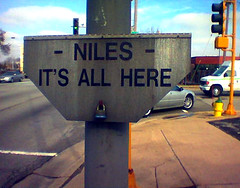 Today the Mayor of Niles, IL (a suburb just north of Chicago that I used to commute to every day -- but now I don't) turned 78. To commemorate the event he was arrested on charges that he’s been abusing his power since 1989 – by steering insurance contracts to a buddy’s business in exchange for kickbacks.
Today the Mayor of Niles, IL (a suburb just north of Chicago that I used to commute to every day -- but now I don't) turned 78. To commemorate the event he was arrested on charges that he’s been abusing his power since 1989 – by steering insurance contracts to a buddy’s business in exchange for kickbacks.The news is reporting that the good folks of Niles are shocked and dismayed that their mayor could be charged with such a thing.
Okay, guys: What part of Chicago don't you understand?
Reminds me of when Governor Ryan was convicted and the folks around here were shrugging their shoulders saying: "Yeah, sure: we all knew he was guilty. But I'm really surprised he was convicted."
Mayor Blase was first elected to the office in 1961.
The Southern Illinois has the best headline »
class war in a coffee cup
A Burger King ad depicts a construction worker, clad in work boots and helmet, chugging the recently introduced BK Joe. Even the in-store promotions at Burger King are defiantly anti-Starbucks: one display in Burger King reads, “Comes in three easy-to-say sizes” (Large, medium and small).From This Joe’s For You in this morning’s New York Times.. . .
Mr. Gilbert [VP of Marketing for Dunkin’ Donuts] acknowledged the superior look of the Starbucks stores, many complete with plush couches, blond-wood café tables and soothing jazz piped through the speakers. But that is not what the “hard-working” Dunkin’ customer wants, he said: “Our customers have stuff they got to do, and most of what they want to do is not taking place in our stores.”
The commodity that is coffee astonishes me. A few years back I did a project for the Seattle Coffee Company (before they were acquired by Starbuck's) and encountered the statistic that coffee is the second largest commodity in the world after oil. (Hope I'm remembering that right.) According to today's piece in the NYT, revenue associated with the coffee trade was up 16% in 2005 over 2004.
[photo credit: jessiqua]
Wednesday, June 07, 2006
bigger, longer & uncut
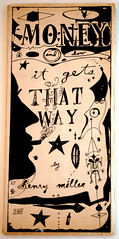 Scored a second run Henry Miller chapbook at the Printers Row Book Fair over the weekend.
Scored a second run Henry Miller chapbook at the Printers Row Book Fair over the weekend.The description maps pretty closely to one that I tracked down on AbeBooks -- the good news is I paid considerably less:
Money And How It Gets That Way.The pages of mine are also uncut, and there's the rub: If I slice the pages, I expect I'll shave down the value of the book. But if I don't slice 'em, I can't read the book.
Miller, Henry.
Description: Second Edition, 1946. Black and white illustrated wrappers, as issued. Fine copy with a touch of darkening and ruffling to top edge, and pages are uncut. Shifreen & Jackson A18c. 1/1500cc. With ingenious illustrations by Jack Wright in text (and cover). 47pp. Dedicated appropriately enough to Ezra Pound. A partly tongue-in-cheek exposition of the concept of currency.
Book Price: $200
Crap.
TD4.2
I had no business reading your mail
you spoke little of her
and I pried less
but when you left the postcard
with its pleasantries
face up beside the guest towels
that you rolled with your
brilliant, brutal hands
I didn't look away
IWALY she signed her name
I will always love you
you are ashes now, friend
you spoke little of her
and I pried less
but when you left the postcard
with its pleasantries
face up beside the guest towels
that you rolled with your
brilliant, brutal hands
I didn't look away
IWALY she signed her name
I will always love you
you are ashes now, friend
but she speaks, too, for me
as I roll this towel
and tuck it carefully aside
WTF? »
as I roll this towel
and tuck it carefully aside
WTF? »
Tuesday, June 06, 2006
gentle on my mind
A few years back I was hanging out in a karaoke bar in Seattle (I suspect I've already told you too much) when a guy stepped to the mic and sang "Gentle on My Mind" -- dedicating it to a leggy brunette in the crowd.
It was the first time I'd heard the song. Glenn Campbell covered in the '70s, but because I made it a point to avoid Campbell I, well, had never heard it.
That night it was absolutely perfect.
The lyrics, you'll know if you're familiar with them, would be caddish if they weren't so honest; the tune is straightforward -- not at all complicated -- but the way this cowboy sang it to his girl friend (it was clear from the way the song unfolded that there was no compound word in this relationship) it was a single perfect piece of sweetness, a perfect moment in time.
Glen does a good job with it, but it’s not quite up to par with my cowboy at the karaoke bar, who disappeared to his back table after he put the number to bed.
I never heard from him again, so since then I've had to settle for Glen »
It was the first time I'd heard the song. Glenn Campbell covered in the '70s, but because I made it a point to avoid Campbell I, well, had never heard it.
That night it was absolutely perfect.
The lyrics, you'll know if you're familiar with them, would be caddish if they weren't so honest; the tune is straightforward -- not at all complicated -- but the way this cowboy sang it to his girl friend (it was clear from the way the song unfolded that there was no compound word in this relationship) it was a single perfect piece of sweetness, a perfect moment in time.
Glen does a good job with it, but it’s not quite up to par with my cowboy at the karaoke bar, who disappeared to his back table after he put the number to bed.
I never heard from him again, so since then I've had to settle for Glen »
TD4.1

oats: raw. wounds: honey.
like two crones at a cauldron
we swap recipes
The TD4 project is all about serving up offerings for a dear ghost in my life. I can promise you that they aren't going to make a whole lot of sense, but as long as he isn't cutting his hair we should be all right.
googlism
Wanna know what Google thinks?
From Googlism: Googlism.com will find out what Google.com thinks of you, your friends or anything!Plug a name into Googlism and it returns simple declarative statements that tell you what (Google thinks) a thing is.
To continue a running theme, here’s what Google thinks of Mies »
(Be forewarned: Googlism isn’t about precision. Googlism is about opinion.)
mies, mies baby
 messin' around with mies #1
messin' around with mies #1Originally uploaded by suttonhoo.
And then, last September, I went ahead and visited a Mies. The Chicago Architecture Foundation runs a periodic Mies and Modernism tour on the IIT campus – my sweetie and I signed up for one Saturday last September.
I’ll spare you the details of wandering through Rem and Jahn’s structures (I would rhapsodize and you might yawn), and the slow meander through Mies’ God Box and the Admissions building. Let’s just say I was slowly warming to the man, to his long lines and suspended steel girders, and I didn’t entirely know why.
 But it wasn’t until we hit Crown Hall that I crossed over.
But it wasn’t until we hit Crown Hall that I crossed over.It was the middle of the afternoon, and the day was overcast – an innocent enough moment to encounter the structure that’s better known for a being a beautiful box of light that beams across the campus at night. The hall was packed with first year architecture students assembled around drafting tables and chalk boards, buzzing with new beginnings.
I don’t understand what happened next, but all I know was: I got giddy.
Something about that building made me high.
The only experience that comes close to what I felt that first time in Mies’ Crown Hall takes a minute to explain: I was 12 and visiting friends; he was 16 and a cousin of theirs.
We were all horsing around in the swimming pool and he picked me up and hurled me across the water – but before he tossed me, he held me just long enough to make me wish he would hold me some more.
That’s all there was too it – a brief, bare moment of experience – I was too young to understand where it could lead, or how messy that would all get – I just wanted that feeling of being held against his chest to last forever. It was pure intoxication without the complications of consummation. Nothing hidden. Every ounce of desire was in plain sight.
 That’s Crown Hall.
That’s Crown Hall.Suspended from the girders that support the building, it’s largely one big room, divided gratuitously by human-sized partitions. The walls are all windows, of course; the base panels are scrim-like; the top panels are pellucid and transparent. A largely iron-free glass makes these panes extraordinarily clear.
I returned to Crown Hall over the weekend as part of an architecture class with Blair Kamin, the architecture critic for the Chicago Tribune. It was the first time I had been back since September, and I suspected that I would be a little more restrained this time.
But I was wrong. The students were gone and the sun was out and the vastness of the hall was even more pronounced.
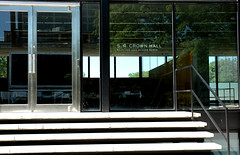 No cold old man of Modernism here. Mies is shockingly transparent in his intentions.
No cold old man of Modernism here. Mies is shockingly transparent in his intentions.Hold me, Mies. Hold me.
See more shots of Mies »
Monday, June 05, 2006
whole lot of pilgrims
“That’s a whole lot of pilgrims.”
Thomas A. Heinz AIA speaking at the Printers Row Book Fair about the fact that 3 Million people visit Frank Lloyd Wright structures every year.
One of the best parts about hearing Thomas Heinz speak about his new book, the Frank Lloyd Wright Field Guide, at the book fair over the weekend was the way he shared his research notes about the people who lived in these houses.
The field guide is notable because it organizes all of the existing domestic and international FLW structures geographically, and with GPS codes (along with street addresses) so that they’re easy to find. He also annotates them with relevant notes so you can decide whether you want to bother finding them.
Each house is named after its original owner, of course, and includes notes about the history of its commission and, where relevant, its evolution. Here’s an example from the Roland Reisley House in Pleasantville, NY (GPS N 41 07.418 // W 73 44.695, if you’re wondering):
The story that he told that stuck with me had to do with the Cheneys, the couple who FLW built a house for in Oak Park, IL during the early part of the 20th Century -- before he ran off with Mrs. Cheney in 1909.
The entry in the field guide is fairly dispassionate, simply noting that the house was built, that Mamah Cheney left with Wright for Europe in 1909, and that Mr. Cheney remarried and continued to live in the house until 1926 when he relocated to St. Louis for business.
But Heinz spent some time noodling at these events during the interview on Sunday, wondering: how could Cheney bear to live in that house – its every detail built and designed by Wright -- after his wife left him for the man? And to continue to live there after horror was added to heartbreak when Cheney’s children were murdered, along with his ex-wife, when a domestic servant went postal at Taliesin in 1914?
Heinz had several theories about what might have made it bearable for Cheney, all of them keying into the children who were born or adopted into that house, and the presence of Mamah’s sister Lizzie, who came to stay with them as a Nanny -- and may well have had a child while she was there. (I’ll let you put the pieces together.)
But the anecdote that stopped me in my tracks was learning how in 1914, when Wright received news of Mamah’s death while he was working on a project in Chicago, he got on the first train back to Taliesin -- with Mr. Cheney. Cheney's children had been killed, after all, and he had boarded the same train on his way to collect their remains.
The two men, the story goes, shared a quiet, civil conversation. What they might have said to each other, on a day when the bottom had fallen out of their worlds -- how the two adversaries would have shared, or simply remarked upon their grief, on that slow ride to Wisconsin -- really has me wondering.
p.s. Watch for Heinz on PBS in the coming months – he’s just wrapping up the posthumous construction of a FLW house on Lake Mahopac north of NYC, and PBS showed up with a film crew to capture some of the fun.
Thomas A. Heinz AIA speaking at the Printers Row Book Fair about the fact that 3 Million people visit Frank Lloyd Wright structures every year.
One of the best parts about hearing Thomas Heinz speak about his new book, the Frank Lloyd Wright Field Guide, at the book fair over the weekend was the way he shared his research notes about the people who lived in these houses.
The field guide is notable because it organizes all of the existing domestic and international FLW structures geographically, and with GPS codes (along with street addresses) so that they’re easy to find. He also annotates them with relevant notes so you can decide whether you want to bother finding them.
Each house is named after its original owner, of course, and includes notes about the history of its commission and, where relevant, its evolution. Here’s an example from the Roland Reisley House in Pleasantville, NY (GPS N 41 07.418 // W 73 44.695, if you’re wondering):
The clients were a physicist who married a psychologist in 1950, both only children. When they were looking for a place to start a family, they took a look at this cooperative and liked it.The fact that Heinz manages to maintain this kind of historical annotation for what appears to approach over 500 listings is a pretty impressive accomplishment in itself.
On 26 October 1950 they sent a five-page letter to Mr. Wright outlining their needs and the $20,000 budget. Wright suggested a meeting, and the Reisleys drove to Taliesin. They got the preliminary drawings in February 1951 but Wright noted the budget now at $30,000, to their surprise.
Wright, then 84, visited Usonia and spent time with them on their site. Excavation began on September 1951, and they moved in in June 1952 although it was a bit unfinished. In the mid-1950s an addition was planned and occupied by early 1957, in time for the birth of the Reisleys’ third child.
The story that he told that stuck with me had to do with the Cheneys, the couple who FLW built a house for in Oak Park, IL during the early part of the 20th Century -- before he ran off with Mrs. Cheney in 1909.
The entry in the field guide is fairly dispassionate, simply noting that the house was built, that Mamah Cheney left with Wright for Europe in 1909, and that Mr. Cheney remarried and continued to live in the house until 1926 when he relocated to St. Louis for business.
But Heinz spent some time noodling at these events during the interview on Sunday, wondering: how could Cheney bear to live in that house – its every detail built and designed by Wright -- after his wife left him for the man? And to continue to live there after horror was added to heartbreak when Cheney’s children were murdered, along with his ex-wife, when a domestic servant went postal at Taliesin in 1914?
Heinz had several theories about what might have made it bearable for Cheney, all of them keying into the children who were born or adopted into that house, and the presence of Mamah’s sister Lizzie, who came to stay with them as a Nanny -- and may well have had a child while she was there. (I’ll let you put the pieces together.)
But the anecdote that stopped me in my tracks was learning how in 1914, when Wright received news of Mamah’s death while he was working on a project in Chicago, he got on the first train back to Taliesin -- with Mr. Cheney. Cheney's children had been killed, after all, and he had boarded the same train on his way to collect their remains.
The two men, the story goes, shared a quiet, civil conversation. What they might have said to each other, on a day when the bottom had fallen out of their worlds -- how the two adversaries would have shared, or simply remarked upon their grief, on that slow ride to Wisconsin -- really has me wondering.
p.s. Watch for Heinz on PBS in the coming months – he’s just wrapping up the posthumous construction of a FLW house on Lake Mahopac north of NYC, and PBS showed up with a film crew to capture some of the fun.
the secret at shadow ranch
You read it. You know you did, you Nancy Drew Mystery girl. (Remember the scene with the buffalo tongues? I thought so.)
Printers Row Book Fair
Chicago, IL
Printers Row Book Fair
Chicago, IL
Sunday, June 04, 2006
rem’s wall
Remember those funky plastic crackerjack toys that changed when you tipped them -- their eyes blinking open and shut? This wall is made of that stuff.
The Campus Center by Rem Koolhaas at IIT
Chicago, IL
The Campus Center by Rem Koolhaas at IIT
Chicago, IL
Subscribe to:
Posts (Atom)
